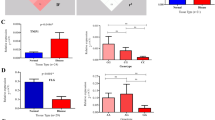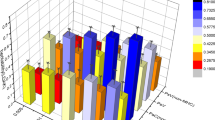Abstract
There is increasing evidence to suggest that the newly discovered cytokines interleukin (IL)-19 and -20 have a role in the function of epidermis and in psoriasis. The genes encoding these cytokines locate into the genomic IL-10 region on human chromosome 1. The aim of the present study was to analyze whether single-nucleotide polymorphisms (SNPs) in these genes have an impact on the susceptibility for psoriasis. From pairwise linkage disequilibrium (LD) matrix of the IL-19 and -20 gene polymorphisms, what reflects the nonrandom association of alleles at these markers, it was apparent that IL-19 and -20 genes form one block of LD. We found that the HT3 CACCGGAA haplotype of the IL-19 and -20 genes was associated with an increased risk of psoriasis, reflecting its role in determining susceptibility to plaque-type psoriasis. Although association analysis of the IL-19 gene indicated that minor alleles of the IL-19 gene SNPs (rs2243188, rs2243169 and rs2243158) revealed protective effect to psoriasis and haplotype analysis of the IL-19 gene proved significant protective effect of the TGATA haplotype in case of late-onset disease, combined haplotype analysis of the IL-19 and -20 genes demonstrated that protective effect of the IL-19 gene is secondary to the susceptibility effect of the IL-20 gene.
This is a preview of subscription content, access via your institution
Access options
Subscribe to this journal
Receive 6 digital issues and online access to articles
$119.00 per year
only $19.83 per issue
Buy this article
- Purchase on Springer Link
- Instant access to full article PDF
Prices may be subject to local taxes which are calculated during checkout

Similar content being viewed by others
References
Bos JD, De Rie MA . The pathogenesis of psoriasis: immunological facts and speculations. Immunol Today 1999; 20: 40–46.
Prinz JC . The role of T cells in psoriasis. JEADV 2003; 17: 257–270.
Griffiths CEM . The immunological basis of psoriasis. JEADV 2003; 17 (Suppl 2): 1–5.
Gudjonsson JE, Johnston A, Sigmundsdottir H, Valdimarsson H . Immunopathogenic mechanisms in psoriasis. Clin Exp Immunol 2004; 135: 1–8.
Romer J, Hasselager E, Norby PL, Steiniche T, Thorn Clausen J, Kragballe K . Epidermal overexpression of interleukin-19 and -20 mRNA in psoriatic skin disappears after short-term treatment with cyclosporine a or calcipotriol. J Invest Dermatol 2003; 121: 1306–1311.
Blumberg H, Conklin D, Xu W et al. Interleukin 20: discovery, receptor identification, and role in epidermal function. Cell 2001; 104: 9–19.
Gallagher G, Dickensheets H, Eskdale J et al. Cloning, expression and initial characterization of interleukin-19 (IL-19), a novel homologue of human interleukin-10 (IL-10). Genes Immun 2000; 1: 442–450.
Wolk K, Kunz S, Asadullah K, Sabat R . Cutting edge: immune cells as sources and targets of the IL-10 family members? J Immunol 2002; 168: 5397–5402.
Dumoutier L, Leemans C, Lejeune D, Kotenko SV, Renauld JC . Cutting edge: STAT activation by IL-19, IL-20 and mda-7 through IL-20 receptor complexes of two types. J Immunol 2001; 167: 3545–3549.
Pletnev S, Magracheva E, Kozlov S et al. Characterization of the recombinant extracellular domains of human interleukin-20 receptors and their complexes with interleukin-19 and interleukin-20. Biochemistry 2003; 42: 12617–12624.
Parrish-Novak J, Xu W, Brender T et al. Interleukins 19, 20, and 24 signal through two distinct receptor complexes. Differences in receptor–ligand interactions mediate unique biological functions. J Biol Chem 2002; 227: 47517–47523.
Liao Y-C, Liang W-G, Chen F-W et al. IL-19 induces production of IL-6 and TNF-α and results in cell apoptosis through TNF-α. J Immunol 2002; 169: 4288–4297.
Kotenko SV . The family of IL-10-related cytokines and their receptors: related, but to what extent? Cytokine Growth Factor Rev 2002; 13: 223–240.
Eskdale J, Kube D, Tesch H, Gallagher G . Mapping of the human IL-10 gene and further characterization of the 5-prime flanking sequence. Immunogenetics 1997; 46: 120–128.
Jiang H, Lin JJ, Su ZZ, Goldstein NI, Fisher PB . Subtraction hybridization identifies a novel melanoma differentiation-associated gene, mda-7, modulated during human melanoma differentiation, growth and progression. Oncogene 1995; 11: 2477–2486.
Johanneson B, Lima G, von Salome J et al. A major susceptibility locus for systemic lupus erythematosus maps to chromosome 1q31. Am J Hum Genet 2002; 71: 1060–1071.
Martinez A, Pascual M, Pascual-Salcedo D, Balsa A, Martin J, de la Concha EG . Genetic polymorphisms in Spanish rheumatoid arthritis patients: an association and linkage study. Genes Immun 2003; 4: 117–121.
Barrera P, Faure S, Prud'homme JF et al. European genetic study on rheumatoid arthritis: is there a linkage of the interleukin-1 (IL-1), IL-10 or IL-4 genes to RA? Clin Exp Rheumatol 2001; 19: 709–714.
Hensen P, Asadullah K, Windemuth C et al. Interleukin-10 promoter polymorphism IL10.G and familial early onset psoriasis. Br J Dermatol 2003; 149: 381–385.
Kingo K, Koks S, Nikopensius T, Silm H, Vasar E . Polymorphisms in the interleukin-20 gene: relationships to plaque-type psoriasis. Genes Immun 2004; 5: 117–121.
Crawley E, Kay R, Sillibourne J, Patel P, Hutchinson I, Woo P . Polymorphic haplotypes of the interleukin-10 5′ flanking region determine variable interleukin-10 transcription and are associated with particular phenotypes of juvenile rheumatoid arthritis. Arthritis Rheum 1999; 42: 1101–1108.
Lim S, Crawley E, Woo P, Barnes PJ . Haplotype associated with low interleukin-10 production in patients with severe asthma. Lancet 1998; 352: 113.
Howell WM, Turner SJ, Bateman AC, Theaker JM . IL-10 promoter polymorphisms influence in cutaneous malignant melanoma. Genes Immun 2001; 2: 25–31.
Shin HD, Wincler C, Stephens JC et al. Genetic restriction of HIV-1 pathogenesis to AIDS by promoter alleles of IL-10. Proc Nat Acad Sci USA 2000; 97: 14467–14472.
Sivalingam SP, Yoon KH, Koh DR, Fong KY . Single-nucleotide polymorphisms of the interleukin-18 gene promoter region in rheumatoid arthritis patients: protective effect of AA genotype. Tissue Antigens 2003; 62: 498–504.
Smith AJ, Keen LJ, Billingham MJ et al. Extended haplotypes and linkage disequilibrium in the IL1R1-IL1A-IL1B-IL1RN gene cluster: association with knee osteoarthritis. Genes Immun 2004; 5: 451–460.
Contu L, Orru S, Carcassi C et al. A psoriasis vulgaris protective gene maps close to the HLA-C locus on the EH18.2-extended haplotype. Tissue Antigens 2004; 64: 43–57.
Hensen P, Windemuth C, Huffmeier U et al. Association scan of the novel psoriasis susceptibility region on chromosome 19: evidence for both susceptible and protective loci. Exp Dermatol 2003; 12: 490–496.
Ye S, Dhillon S, Ke X, Collins AR, Day IN . An efficient procedure for genotyping single nucleotide polymorphisms. Nucleic Acids Res 2001; 29: E88–8.
Tregouet DA, Barbaux S, Escolano S et al. Specific haplotypes of the P-selectin gene are associated with myocardial infarction. Hum Mol Genet 2002; 11: 2015–2023.
Acknowledgements
This study was supported by the target-based funding from the Estonian Ministry of Education Grant No. 0182128s02 (PARNH2128), by the Estonian Science Foundation Grants No. 5712 and 5688 and by the Centre of Molecular and Clinical Medicine Grant VARMC-TIPP.
Author information
Authors and Affiliations
Corresponding author
Rights and permissions
About this article
Cite this article
Kõks, S., Kingo, K., Rätsep, R. et al. Combined haplotype analysis of the interleukin-19 and -20 genes: relationship to plaque-type psoriasis. Genes Immun 5, 662–667 (2004). https://doi.org/10.1038/sj.gene.6364141
Received:
Revised:
Accepted:
Published:
Issue Date:
DOI: https://doi.org/10.1038/sj.gene.6364141
Keywords
This article is cited by
-
The Role of Pharmacogenetics in Chronic Plaque Psoriasis: Update of the Literature
Molecular Diagnosis & Therapy (2017)
-
Transcriptional landscape of psoriasis identifies the involvement of IL36 and IL36RN
BMC Genomics (2015)
-
Polymorphisms in the interleukin-10 gene cluster are possibly involved in the increased risk for major depressive disorder
BMC Medical Genetics (2008)
-
Association analysis of IL20RA and IL20RB genes in psoriasis
Genes & Immunity (2008)
-
Modulation of the human cytokine response by interferon lambda-1 (IFN-λ1/IL-29)
Genes & Immunity (2007)



